Des Moines, Iowa 作者: 来源: 发布时间:2021-11-04
I.Population and Area
₋Area
Land: 88.18 sq mi (228.39 km2)
₋Population
Total: 214,237
Density: 2,429.46/sq mi (938.02/km2)
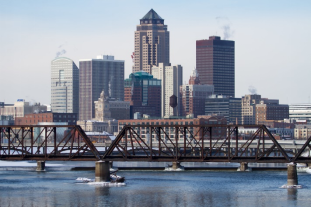
II.Natural Geography
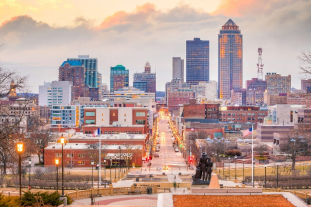
Street View & Overview
₋Des Moines (/dɪˈmɔɪn/) is the capital and the most populous city in the U.S. state of Iowa. It is also the county seat of Polk County. A small part of the city extends into Warren County. It was incorporated on September 22, 1851, as Fort Des Moines, which was shortened to "Des Moines" in 1857. It is located on, and named after, the Des Moines River, which likely was adapted from the early French name, Rivière des Moines, meaning "River of the Monks". The city's population was 214,237 as of the 2019 population estimate. The six-county metropolitan area is ranked 83rd in terms of population in the United States with 699,292 residents according to the 2019 estimate by the United States Census Bureau, and is the largest metropolitan area fully located within the state. A portion of the larger Omaha, Nebraska, metropolitan area extends into three counties of southwest Iowa.
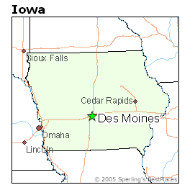
₋Des Moines is a major center of the US insurance industry and has a sizable financial services and publishing business base. The city was credited as the "number one spot for U.S. insurance companies" in a Business Wire article and named the third-largest "insurance capital" of the world. The city is the headquarters for the Principal Financial Group, the Meredith Corporation, Ruan Transportation, TMC Transportation, EMC Insurance Companies, and Wellmark Blue Cross Blue Shield. Other major corporations such as Wells Fargo, Voya Financial, Nationwide Mutual Insurance Company, ACE Limited, Marsh, Monsanto, and DuPont Pioneer have large operations in o r near the metropolitan area. In recent years, Microsoft, Hewlett Packard, and Facebook have built data-processing and logistical facilities in the Des Moines area. Forbes ranked Des Moines as the "Best Place for Business" in both 2010 and 2013. In 2014, NBC ranked Des Moines as the "Wealthiest City in America" according to its criteria.
₋Des Moines is an important city in U.S. presidential politics; as the state's capital, it is the site of the first caucuses of the presidential primary cycle. Many presidential candidates set up campaign headquarters in Des Moines. A 2007 article in The New York Times said, "If you have any desire to witness presidential candidates in the most close-up and intimate of settings, there is arguably no better place to go than Des Moines."
III.ECONOMY
₋The average salary in Des Moines, IA is $62k. Trends in wages decreased by -0.8 percent in Q1 2020. The cost of living in Des Moines, IA is 10 percent higher than the national average. The most popular occupations in Des Moines, IA are Software Engineer, Project Manager, (Unspecified Type / General), and Software Developer which pay between $39k and $105k per year. The most popular employers in Des Moines, IA are Principal Financial Group, UnityPoint Health, and Meredith Corporation.
₋Website: https://www.payscale.com/research/US/Location=Des-Moines-IA/Salary
IV.Industrial Characteristics
₋Many insurance companies are headquartered in Des Moines, including the Principal Financial Group, EMC Insurance Group, Fidelity & Guaranty Life, Allied Insurance, GuideOne Insurance, Wellmark Blue Cross Blue Shield of Iowa, and American Republic Insurance Company. Des Moines has been referred to as the "Hartford of the West" because of this. The Principal is one of two Fortune 500 companies with headquarters in Iowa, ranking 273rd on the magazine's list in 2009.
₋As a center of financial and insurance services, other major corporations headquartered outside of Iowa have a presence in the Des Moines Metro area, including Wells Fargo, Voya Financial, and Electronic Data Systems (EDS). The Meredith Corporation, a leading publishing and marketing company, is also based in Des Moines. Meredith publishes Better Homes and Gardens, one of the most widely circulated publications in the United States. Des Moines was also the headquarters of Golf Digest magazine.
₋Other major employers in Des Moines include UnityPoint Health, Mercy Medical Center, MidAmerican Energy Company, CDS Global, UPS, Firestone Agricultural Tire Company, EDS, Drake University, Titan Tire, The Des Moines Register, Anderson Erickson, Dee Zee and EMCO.
₋In 2010, Forbes magazine ranked the Des Moines metropolitan area first on its list of "Best Places For Business And Careers", based on factors such as the cost of doing business, cost of living, educational attainment, and crime rate.
₋In 2017, Kemin Industries opened a state-of-the-art worldwide headquarters building in Des Moines.
V.Attractions
1.Greater Des Moines Botanical Garden
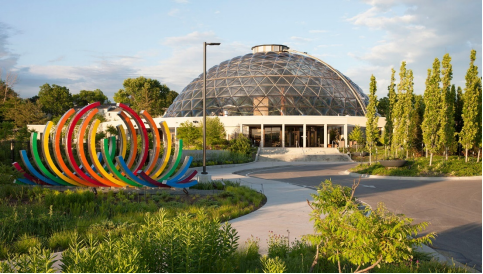
₋The Greater Des Moines Botanical Garden (14 acres / 5.7 hectares) (known as the Des Moines Botanical Center until 2013) is a botanical garden located in Des Moines, Iowa, United States, on the east bank of the Des Moines River.
₋Interest in a Des Moines botanical center began in 1929. A city greenhouse was acquired on the west side of the river in 1939, which served the city as a production and display greenhouse until the Botanical Center was completed in 1979. From 2004 to December 31, 2012, the facility was operated on behalf of the city by Des Moines Water Works. On January 2, 2013, the Greater Des Moines Botanical Garden opened for the first time as a nonprofit organization under the leadership of president and CEO Stephanie Jutila and the governance of the Greater Des Moines Botanical Garden Board of Directors. The institution is undergoing a dynamic renewal funded by a successful capital campaign to raise $12.6 million for the Phase I expansion of the outdoor gardens and improvements to the existing conservatory and building.
₋The conservatory has over a 1,200 different taxa from around the world in artistic settings designed to explore, explain and celebrate the majesty of the plant world. Future outdoor gardens, designed by the Chicago-based landscape architect Doug Hoerr, will include a new rose garden, entrance garden, nearly 0.5-acre water garden, maple allée, belvedere overlooking the Des Moines River, celebration lawn and walled perennial border, conifer and gravel garden, a hillside garden, and an annual and bulb parterre. These gardens reflect the institution's commitment to developing gardens as forms of public art. The gardens will feature rich annual color designs conceived around artistic concepts inspired from music, history, art and pop culture, utilizing plants as the ingredients for exhibitions.
₋From the 1986 until the mid 2000s, the Botanical Center was a used as a Do It Yourself venue for the Des Moines Underground, Punk and Hardcore Music scene. Countless national touring acts such as Henry Rollins, Scream, Saint Vitus, Regional and Local bands played shows for all ages in the rental halls there. Often these bands and their fans had no other venue open to them in the area and for that reason the Botanical Center provided a much needed space for the music scene.
₋According to a contest on the WHO Radio Van & Bonnie morning show on June 21, 2011, the dome is constructed of 665 plexiglass panels.
₋Address: 909 Robert D. Ray Dr, Des Moines, IA 50309, United States
₋Phone: +1 515-323-6290
₋Website: https://www.dmbotanicalgarden.com/
2. Iowa State Capitol
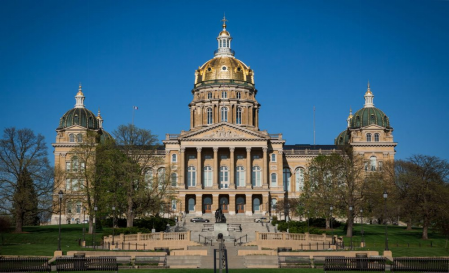
₋The Iowa State Capitol, commonly called the Iowa Statehouse, is in Iowa's capital city, Des Moines. As the seat of the Iowa General Assembly, the building houses the Iowa Senate, Iowa House of Representatives, the Office of the Governor, and the Offices of the Attorney General, Auditor, Treasurer, and Secretary of State. The building also includes a chamber for the Iowa Supreme Court, although court activities usually take place in the neighboring Iowa Supreme Court building. The building was constructed between 1871 and 1886, and is the only five-domed capitol in the country.
₋Located at East 9th Street and Grand Avenue, the Capitol is set atop a hill and offers a panoramic view of the city's downtown and the West Capitol Terrace. Various monuments and memorials are to its sides and front, including the Soldiers and Sailors' Monument and the Lincoln and Tad statue.
₋Not long after achieving statehood, Iowa recognized that the Capitol should be moved farther west than Iowa City, and the 1st General Assembly, in 1846, authorized a commission to select a location. In 1847, the town of Monroe City, in Jasper County, was selected as the new location of the capitol and platted out, but the 1848 Legislature decided not to move the capitol from Iowa City. In 1854, the General Assembly decreed a location “within two miles of the Raccoon fork of the Des Moines River.” The exact spot was chosen when Wilson Alexander Scott gave the state nine and one-half acres where the Capitol now stands. Final legislative approval for the construction of a permanent statehouse was given on April 8, 1870.
₋A three-story brick building served as a temporary Capitol and was in use for 30 years, until destroyed by fires: in the meantime, the permanent Capitol was being planned and built.
₋In 1870, the General Assembly established a Capitol commission to employ an architect, choose a plan for a building (not to cost more than $1.5 million), and proceed with the work, but only by using funds available without increasing the tax rate.
₋John C. Cochrane and Alfred H. Piquenard were designated as architects, and a cornerstone was laid on November 23, 1871. However, much of the original stone deteriorated through waterlogging and severe weather, and had to be replaced. The cornerstone was relaid on September 29, 1873.
₋Although the building could not be constructed for $1.5 million as planned, the Cochrane and Piquenard design was retained, and modifications were undertaken. Cochrane resigned in 1872, but Piquenard continued until his death in 1876. He was succeeded by two of his assistants, Mifflin E. Bell and W.F. Hackney. Bell redesigned the dome so that it better fit the proportions of the building. Hackney was the only architect who stayed on the project until the end.
₋The capitol building was dedicated on January 17, 1884, and it was completed sometime in 1886. The building commission made its final report on June 29, 1886, with a total cost of $2,873,294.59. The audit showed that only $3.77 was unaccounted for in the 15 years of construction.
₋Address: 1007 E Grand Ave, Des Moines, IA 50319, United States
₋Opened: 1886
₋Phone: +1 515-281-5591
₋Website: https://www.catchdesmoines.com/listing/iowa-state-capitol/361/
3. Des Moines Art Center
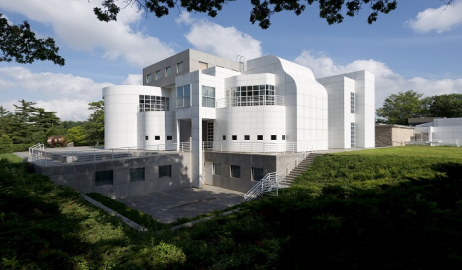
₋The Des Moines Art Center is an art museum with an extensive collection of paintings, sculpture, modern art and mixed media. It was established in 1948 in Des Moines, Iowa.
₋The Art Center traces its roots to 1916, when the Des Moines Association of Fine Arts established gallery space at the Public Library of Des Moines on the banks of the Des Moines River downtown. Several exhibitions were shown each year, and works of art were periodically purchased for the association's permanent collection. In 1938, the DMAF moved their collection to a building on Walnut Street. Planning for a permanent building began in 1943 after a sizeable donation from the trust of James D. Edmundson. In 1945, DMAF evolved into the Des Moines Art Center. A site along Grand Avenue in the city's Greenwood Park was designated as the preferred location. Construction began in 1945; the museum itself opened in 1948, with additional wings constructed in 1968 and 1985.
₋In 2009, the Art Center expanded its mission to operate the Pappajohn Sculpture Park, located in Western Gateway Park downtown.
₋Artists included in the permanent collection are Edward Hopper, Jasper Johns, Andy Warhol, Henri Matisse, Claude Monet, Francis Bacon, Georgia O'Keeffe, Gerhard Richter, Claes Oldenburg, Mary Cassatt, Auguste Rodin, Grant Wood, Deborah Butterfield, Paul Gauguin, Eva Hesse, Ronnie Landfield, Roy Lichtenstein, George Segal, Mark Rothko, John Singer Sargent, Joseph Cornell and Takashi Murakami.
₋Some paintings from the collection are well known examples of the artist and/or movement they represent. These include Edward Hopper's Automat from 1927, which was reproduced on a postage stamp as well as used for a cover of Time, Stanton MacDonald Wright's Synchromy which has been reproduced in numerous texts about the artist/movement, Francis Bacon's Portrait of Pope Innocent from 1953 which likewise is considered a signature work by the artist and appeared in Robert Hughes "Shock of the New" BBC series in the early 1980s.
₋Address: 4700 Grand Ave, Des Moines, IA 50312, United States
₋Director: Jeff Fleming
₋Phone: +1 515-277-4405
₋Website: https://www.desmoinesartcenter.org/
VI.History
₋Origin of Fort Des Moines
₋Des Moines traces its origins to May 1843, when Captain James Allen supervised the construction of a fort on the site where the Des Moines and Raccoon Rivers merge. Allen wanted to use the name Fort Raccoon; however, the U.S. War Department preferred Fort Des Moines. The fort was built to control the Sauk and Meskwaki Indians, whom the government had moved to the area from their traditional lands in eastern Iowa. The fort was abandoned in 1846 after the Sauk and Meskwaki were removed from the state and shifted to the Indian Territory.
₋The Sauk and Meskwaki did not fare well in Des Moines. The illegal whiskey trade, combined with the destruction of traditional lifeways, led to severe problems for their society. One newspaper reported:
₋"It is a fact that the location of Fort Des Moines among the Sac and Fox Indians (under its present commander) for the last two years, had corrupted them more and lowered them deeper in the scale of vice and degradation, than all their intercourse with the whites for the ten years previous".
₋After official removal, the Meskwaki continued to return to Des Moines until around 1857.
₋Archaeological excavations have shown that many fort-related features survived under what is now Martin Luther King, Jr. Parkway and First Street. Soldiers stationed at Fort Des Moines opened the first coal mines in the area, mining coal from the riverbank for the fort's blacksmith.
₋Early, non-Native American, settlement
₋Settlers occupied the abandoned fort and nearby areas. On May 25, 1846, the state legislature designated Fort Des Moines as the seat of Polk County. Arozina Perkins, a school teacher who spent the winter of 1850–1851 in the town of Fort Des Moines, was not favorably impressed:
₋This is one of the strangest looking "cities" I ever saw... This town is at the juncture of the Des Moines and Raccoon Rivers. It is mostly a level prairie with a few swells or hills around it. We have a court house of "brick" and one church, a plain, framed building belonging to the Methodists. There are two taverns here, one of which has a most important little bell that rings together some fifty boarders. I cannot tell you how many dwellings there are, for I have not counted them; some are of logs, some of brick, some framed, and some are the remains of the old dragoon houses... The people support two papers and there are several dry goods shops. I have been into but four of them... Society is as varied as the buildings are. There are people from nearly every state, and Dutch, Swedes, etc.
₋In May 1851, much of the town was destroyed during the Flood of 1851. "The Des Moines and Raccoon Rivers rose to an unprecedented height, inundating the entire country east of the Des Moines River. Crops were utterly destroyed, houses and fences swept away." The city started to rebuild from scratch.
₋Era of growth
₋On September 22, 1851, Des Moines was incorporated as a city; the charter was approved by voters on October 18. In 1857, the name "Fort Des Moines" was shortened to "Des Moines", and it was designated as the second state capital, previously at Iowa City. Growth was slow during the Civil War period, but the city exploded in size and importance after a railroad link was completed in 1866.
₋In 1864, the Des Moines Coal Company was organized to begin the first systematic mining in the region. Its first mine, north of town on the river's west side, was exhausted by 1873. The Black Diamond mine, near the south end of the West Seventh Street Bridge, sank a 150-foot (46 m) mine shaft to reach a 5-foot-thick (1.5 m) coal bed. By 1876, this mine employed 150 men and shipped 20 carloads of coal per day. By 1885, numerous mine shafts were within the city limits, and mining began to spread into the surrounding countryside. By 1893, 23 mines were in the region. By 1908, Des Moines' coal resources were largely exhausted. In 1912, Des Moines still had eight locals of the United Mine Workers union, representing 1,410 miners. This was about 1.7% of the city's population in 1910.
₋By 1880, Des Moines had a population of 22,408, making it Iowa's largest city. It displaced the three Mississippi River ports: Burlington, Dubuque, and Davenport, that had alternated holding the position since the territorial period. Des Moines has remained Iowa's most populous city. In 1910, the Census Bureau reported Des Moines' population as 97.3% white and 2.7% black, reflecting its early settlement pattern primarily by ethnic Europeans.
₋"City Beautiful" project, decline and rebirth
₋At the turn of the 20th century, Des Moines undertook a "City Beautiful" project in which large Beaux Arts public buildings and fountains were constructed along the Des Moines River. The former Des Moines Public Library building (now the home of the World Food Prize); the United States central Post Office, built by the federal government (now the Polk County Administrative Building, with a newer addition); and the City Hall are surviving examples of the 1900–1910 buildings. They form the Civic Center Historic District.
₋The ornate riverfront balustrades that line the Des Moines and Raccoon Rivers were built by the federal Civilian Conservation Corps in the mid-1930s, during the Great Depression under Democratic President Franklin D. Roosevelt, as a project to provide local employment and improve infrastructure. The ornamental fountains that stood along the riverbank were buried in the 1950s, when the city began a postindustrial decline which lasted until the late 1980s. The city has since rebounded, transforming from a blue-collar industrial city to a white-collar professional city.
₋In 1907, the city adopted a city commission government known as the Des Moines Plan, comprising an elected mayor and four commissioners, all elected at-large, who were responsible for public works, public property, public safety, and finance. Considered progressive at the time, it diluted the votes of ethnic and national minorities, who generally could not command the majority to elect a candidate of their choice.
₋That form of government was scrapped in 1950 in favor of a council-manager government, with the council members elected at-large. In 1967, the city changed its government to elect four of the seven city council members from single-member districts or wards, rather than at-large. This enabled broader representation of voters. As with many major urban areas, the city core began losing population to the suburbs in the 1960s (the peak population of 208,982 was recorded in 1960), as highway construction led to new residential construction outside the city. The population was 198,682 in 2000 and grew slightly to 200,538 in 2009. The growth of the outlying suburbs has continued, and the overall metropolitan-area population is over 600,000 today.
₋During the Great Flood of 1993, heavy rains throughout June and early July caused the Des Moines and Raccoon Rivers to rise above flood-stage levels. The Des Moines Water Works was submerged by flood waters during the early morning hours of July 11, 1993, leaving an estimated 250,000 people without running water for 12 days and without drinking water for 20 days. Des Moines suffered major flooding again in June 2008 with a major levee breach. The Des Moines river is controlled upstream by Saylorville Reservoir. In both 1993 and 2008, the flooding river overtopped the reservoir spillway.
₋Today, Des Moines is a member of ICLEI Local Governments for Sustainability USA. Through ICLEI, Des Moines has implemented "The Tomorrow Plan", a regional plan focused on developing central Iowa in a sustainable fashion, centrally-planned growth, and resource consumption to manage the local population.
VII.Other Information
₋Transportation
₋Des Moines has an extensive skywalk system within its downtown core. With over four miles of enclosed walkway, it is one of the largest of such systems in the United States. The Des Moines Skywalk System has been criticized for hurting street-level business, though a recent initiative has been made to make street-level Skywalk entrances more visible.
₋Interstate 235 (I-235) cuts through the city, and I-35 and I-80 both pass through the Des Moines metropolitan area, as well as the city of Des Moines. On the northern side of the city of Des Moines and passing through the cities of Altoona, Clive, Johnston, Urbandale and West Des Moines, I-35 and I-80 converge into a long concurrency while I-235 takes a direct route through Des Moines, Windsor Heights, and West Des Moines before meeting up with I-35 and I-80 on the western edge of the metro. The Des Moines Bypass passes south and east of the city. Other routes in and around the city include US 6, US 69, Iowa 28, Iowa 141, Iowa 163, Iowa 330, and Iowa 415.
₋Des Moines's public transit system, operated by DART (Des Moines Area Regional Transit), which was the Des Moines Metropolitan Transit Authority until October 2006, consists entirely of buses, including regular in-city routes and express and commuter buses to outlying suburban areas.
₋Characteristics of household ownership of cars in Des Moines are similar to national averages. In 2015, 8.5 percent of Des Moines households lacked a car, and increased to 9.6 percent in 2016. The national average was 8.7 percent in 2016. Des Moines averaged 1.71 cars per household in 2016, compared to a national average of 1.8.
₋Burlington Trailways, Jefferson Lines, and Megabus run long-distance, inter-city bus routes through Des Moines.
₋Although Des Moines was historically a train hub, it does not have passenger train service. For east-west traffic it was served by The Rock Island's Corn Belt Rocket express from Omaha to the west, to Chicago in the east. The Rock Island also offered the Twin Star Rocket to Minneapolis to the north and Dallas and Houston to the south. Northward and northwest bound, there were Chicago and North Western trains to destinations including Minneapolis. The Wabash Railroad ran service to the southeast to St. Louis.
₋The nearest Amtrak station is Osceola, about 40 miles (64 km) south of Des Moines, with no connecting Amtrak Thruway Motorcoach. Osceola is served by the California Zephyr, running between Chicago and Emeryville, CA. There have been proposals to extend the as-of-July-2017-upcoming Quad Cities Amtrak service along the Iowa Interstate Railroad main line to Des Moines proper.
₋The Des Moines International Airport (DSM), on Fleur Drive in the southern part of Des Moines, offers nonstop service to destinations within the United States. The only international service is cargo service, but there have been discussions about adding an international terminal.
₋Education
₋The Des Moines Public Schools district is the largest community school district in Iowa with 32,062 enrolled students as of the 2012–2013 school year. The district consists of 63 schools: 38 elementary schools, eleven middle schools, five high schools (East, Hoover, Lincoln, North, and Roosevelt), and ten special schools and programs. Small parts of the city are instead served by Carlisle Community Schools, Johnston Community School District, the Southeast Polk Community School District and the Saydel School District Grand View Christian School is the only private school in the city, although Des Moines Christian School (in Des Moines from 1947 to 2006) in Urbandale, Iowa Christian Academy and Dowling Catholic High School in West Des Moines, and Ankeny Christian Academy on the north side of the metro area serve some city residents.
₋Des Moines is also home to the main campuses of three four-year private colleges: Drake University, Grand View University, and Mercy College of Health Sciences. The University of Iowa has a satellite facility in the city's Western Gateway Park, while Iowa State University hosts Master of Business Administration classes downtown. Simpson College, Upper Iowa University, William Penn University, and Purdue University Global. Des Moines Area Community College is the area's community college with campuses in Ankeny, Des Moines, and West Des Moines. The city is also home to Des Moines University, an osteopathic medical school.
VIII.Contact Information
Government
Type: Council–manager government
Mayor: Frank Cownie (D)
City Hall
Hours: Monday – Friday 8:00 a.m. – 4:30 p.m.
General Email Address: sos@sos.iowa.gov
Contact Webmaster: sos@sos.iowa.gov
Website: https://sos.iowa.gov/contactus.html
